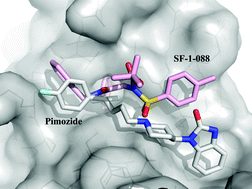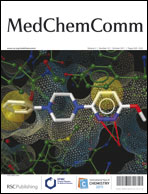This month sees the following articles in MedChemComm that are in the top ten most accessed:-
Molecular obesity, potency and other addictions in drug discovery
Michael M. Hann
Med. Chem. Commun., 2011, 2, 349-355, DOI: 10.1039/C1MD00017A
Identification of target family directed bioisosteric replacements
Anne Mai Wassermann and Jürgen Bajorath
Med. Chem. Commun., 2011, 2, 601-606, DOI: 10.1039/C1MD00066G
Synthesis and biological evaluation of tetrazole containing compounds as possible anticancer agents
Chebolu Naga Sesha Sai Pavan Kumar, Dusmant Kumar Parida, Amlipur Santhoshi, Anil Kumar Kota, Balasubramanian Sridhar and Vaidya Jayathirtha Rao
Med. Chem. Commun., 2011, 2, 486-492, DOI: 10.1039/C0MD00263A
Aromatic chloride to nitrile transformation: medicinal and synthetic chemistry
Lyn H. Jones, Nicholas W. Summerhill, Nigel A. Swain and James E. Mills
Med. Chem. Commun., 2010, 1, 309-318, DOI: 10.1039/C0MD00135J
Computational ligand-based rational design: role of conformational sampling and force fields in model development
Jihyun Shim and Alexander D. MacKerell, Jr.
Med. Chem. Commun., 2011, 2, 356-370, DOI: 10.1039/C1MD00044F
N1-Benzyl substituted cambinol analogues as isozyme selective inhibitors of the sirtuin family of protein deacetylases
Federico Medda, Thomas L. Joseph, Lisa Pirrie, Maureen Higgins, Alexandra M. Z. Slawin, Sonia Lain, Chandra Verma and Nicholas J. Westwood
Med. Chem. Commun., 2011, 2, 611-615, DOI: 10.1039/C1MD00023C
Antimycobacterial activity of spirooxindolo-pyrrolidine, pyrrolizine and pyrrolothiazole hybrids obtained by a three-component regio- and stereoselective 1,3-dipolar cycloaddition
Stephen Michael Rajesh, Subbu Perumal, J. Carlos Menéndez, Perumal Yogeeswari and Dharmarajan Sriram
Med. Chem. Commun., 2011, 2, 626-630, DOI: 10.1039/C0MD00239A
Synthesis and SAR studies of benzimidazole derivatives as melanin concentrating hormone receptor 1 (MCHR1) antagonists: Focus to detune hERG inhibition
Pradip K. Sasmal, Sanjita Sasmal, Chandrasekhar Abbineni, B. Venkatesham, P. Tirumala Rao, M. Roshaiah, Ish Khanna, V. J. Sebastian, J. Suresh, Manvendra P. Singh, Rashmi Talwar, Dhanya Shashikumar, K. Harinder Reddy, Thomas M. Frimurer, Øystein Rist, Lisbeth Elster and Thomas Högberg
Med. Chem. Commun., 2011, 2, 385-389, DOI: 10.1039/C1MD00015B
Glycosylated porphyrin derivatives and their photodynamic activity in cancer cells
Seenuvasan Vedachalam, Bo-Hwa Choi, Kalyan Kumar Pasunooti, Kun Mei Ching, Kijoon Lee, Ho Sup Yoon and Xue-Wei Liu
Med. Chem. Commun., 2011, 2, 371-377, DOI: 10.1039/C0MD00175A
Intramolecular hydrogen bonding to improve membrane permeability and absorption in beyond rule of five chemical space
Alexander Alex, David S. Millan, Manuel Perez, Florian Wakenhut and Gavin A. Whitlock
Med. Chem. Commun., 2011, 2, 669-674, DOI: 10.1039/C1MD00093D
Why not take a look at the articles today and blog your thoughts and comments below.
Fancy submitting an article to MedChemComm? Then why not submit to us today or alternatively email us your suggestions.
 On the cover of Issue 11 is a hot article from Mark Bradley and coworkers on a method to track innate immune cell migration in vivo using dye-labelled peptoids.
On the cover of Issue 11 is a hot article from Mark Bradley and coworkers on a method to track innate immune cell migration in vivo using dye-labelled peptoids.











 This mini-review from
This mini-review from 


